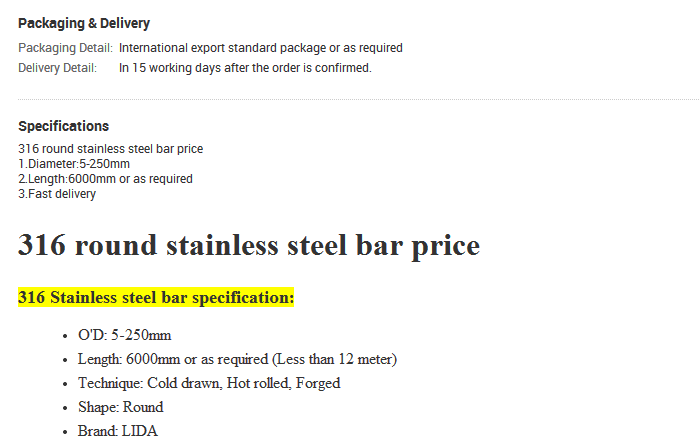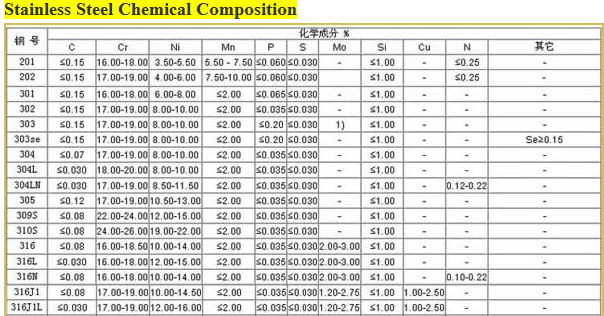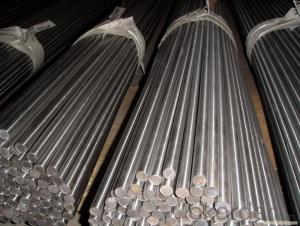316 round stainless steel bar price for china manufacture
- Loading Port:
- Tianjin
- Payment Terms:
- TT OR LC
- Min Order Qty:
- 100 kg
- Supply Capability:
- 1000 kg/month
OKorder Service Pledge
Quality Product, Order Online Tracking, Timely Delivery
OKorder Financial Service
Credit Rating, Credit Services, Credit Purchasing
You Might Also Like



- Q:Can stainless steel pipes be used for brewery and beverage industry applications?
- Stainless steel pipes are suitable for use in brewery and beverage industry applications. This material is renowned for its exceptional corrosion resistance and hygienic properties, making it an ideal option for these sectors. The presence of high levels of chromium and nickel in stainless steel pipes provides excellent protection against corrosion caused by chemicals, acids, and high temperatures. Moreover, stainless steel pipes are easy to clean and maintain, ensuring the highest level of hygiene required in brewery and beverage production. The smooth inner surface of these pipes also reduces the risk of contamination and bacterial growth, making them even more suitable for these applications. In summary, stainless steel pipes offer durability, reliability, and sanitary features that make them the preferred choice for the brewery and beverage industry.
- Q:What is the difference between 2205 and 316L stainless steel pipes?
- The main difference between 2205 and 316L stainless steel pipes lies in their chemical composition and their intended applications. 2205 stainless steel is a duplex stainless steel, meaning it is composed of two phases - austenite and ferrite. This composition gives it excellent corrosion resistance, especially in environments with high chloride content. 2205 stainless steel pipes are commonly used in industries such as oil and gas, chemical processing, and marine applications, where resistance to corrosion and high strength are crucial. On the other hand, 316L stainless steel is an austenitic stainless steel with a lower carbon content compared to other grades in the 300 series. It offers good corrosion resistance, especially to acids and chloride solutions, making it suitable for various applications, including food processing, pharmaceuticals, and medical equipment manufacturing. In terms of mechanical properties, 2205 stainless steel pipes generally have higher tensile strength and yield strength compared to 316L stainless steel pipes. This makes 2205 pipes more suitable for applications requiring greater strength and load-bearing capabilities. It is important to note that both grades of stainless steel pipes have their own advantages and limitations. The choice between 2205 and 316L stainless steel pipes depends on the specific application, environmental conditions, and budgetary considerations. Consulting with a materials engineer or a stainless steel expert can help determine the most suitable grade for a particular project.
- Q:What is the difference between stainless steel tube 304L and 304N?
- 304L is a variety of 304 stainless steel with low carbon content, used for occasions where welding is required.
- Q:Are stainless steel pipes suitable for beer brewing applications?
- Yes, stainless steel pipes are highly suitable for beer brewing applications. Stainless steel is a popular choice in the brewing industry due to its excellent corrosion resistance, durability, and hygiene properties. The smooth surfaces of stainless steel pipes prevent the buildup of bacteria, yeast, and other contaminants, ensuring a clean and safe brewing environment. Stainless steel pipes also have high temperature resistance, which is essential for various brewing processes such as boiling and sterilization. Additionally, stainless steel is an inert material, meaning it does not react with the beer, preserving the taste and quality of the final product. Overall, stainless steel pipes provide the necessary qualities for beer brewing applications and are widely used in the industry.
- Q:What is the difference between seamless and precision stainless steel pipes?
- Seamless and precision stainless steel pipes vary in how they are made and their performance characteristics. Seamless stainless steel pipes are created through extrusion or piercing, where a solid cylindrical billet is heated and a piercing rod forms a hollow tube. This process ensures a smooth and even surface without any seams or welds. The absence of seams eliminates the risk of leakage or weak points, making seamless pipes highly reliable and suitable for a range of uses. On the other hand, precision stainless steel pipes are manufactured through cold-drawn or cold-rolled methods. This involves further processing a seamless pipe to achieve precise dimensions, tolerances, and surface finishes. The precision process enhances the mechanical properties of the pipe, such as strength, hardness, and durability. Precision pipes are commonly used in industries that require tight tolerances and superior surface quality, like automotive, aerospace, and medical applications. In terms of performance, seamless stainless steel pipes offer excellent corrosion and high temperature resistance, as well as good mechanical properties. They are often used in industries such as oil and gas, chemical processing, and power generation, where reliability and strength are vital. Precision stainless steel pipes, on the other hand, are known for their dimensional accuracy, smooth surface finishes, and superior mechanical properties. They are commonly used in precision engineering, instrumentation, and high-performance applications. In summary, the main difference between seamless and precision stainless steel pipes lies in their manufacturing process and intended applications. Seamless pipes are produced without any seams, providing excellent reliability. Precision pipes undergo further processing to achieve precise dimensions and superior surface quality for specific industries and applications.
- Q:What is the difference between 304H and 304L stainless steel pipes?
- The carbon content is the main distinction between 304H and 304L stainless steel pipes. 304H pipes contain a higher carbon content, typically ranging from 0.04-0.10%, making them ideal for high-temperature uses. This increased carbon content enhances their strength and resistance to sensitization, which is the creation of chromium carbides at grain boundaries, resulting in reduced corrosion resistance. On the flip side, 304L stainless steel pipes possess a lower carbon content, usually around 0.03%, making them more appropriate for welding purposes. The reduced carbon content helps minimize the formation of chromium carbides, thereby lowering the risk of sensitization during welding. As a result, corrosion resistance is improved, and weldability is enhanced. To summarize, albeit both 304H and 304L stainless steel pipes are variations of the 304 grade, their distinction lies in their carbon content. 304H pipes are favored for high-temperature applications due to their higher carbon content and improved high-temperature strength, while 304L pipes are better suited for welding applications due to their lower carbon content and enhanced weldability.
- Q:Can stainless steel pipes be used for fire protection systems?
- Indeed, fire protection systems can utilize stainless steel pipes. Due to its exceptional resistance to corrosion and ability to endure high temperatures, stainless steel is well-suited for fire protection purposes. Sprinkler systems, fire hydrants, and fire suppression systems frequently employ stainless steel pipes. These pipes boast durability and a prolonged lifespan, guaranteeing dependable performance within fire protection systems. Moreover, stainless steel pipes are non-combustible and do not propagate the spread of fire, rendering them an optimal selection for fire safety measures.
- Q:Can stainless steel pipes be insulated with polycarbonate?
- No, stainless steel pipes cannot be insulated with polycarbonate. Polycarbonate is a type of thermoplastic material that is typically used for its transparency, impact resistance, and insulation properties. While it can be used to insulate certain types of pipes, such as PVC or copper, it is not suitable for insulating stainless steel pipes. Stainless steel pipes are generally used for high-temperature applications or corrosive environments, and require insulation materials that can withstand these conditions. Therefore, it is recommended to use insulation materials specifically designed for stainless steel pipes, such as mineral wool, fiberglass, or foam pipe insulation.
- Q:Are stainless steel pipes suitable for underground heating systems?
- Indeed, underground heating systems can employ stainless steel pipes as they possess suitability. The reason lies in the fact that stainless steel exhibits remarkable resistance against corrosion and can endure the severe circumstances of subterranean burial. Moreover, this material showcases durability, longevity, and the ability to withstand elevated temperatures and pressures, rendering it an exemplary option for heating systems. Not only that, but stainless steel pipes also offer ease in installation and maintenance, thereby furnishing a dependable and effective resolution for underground heating systems.
- Q:How do stainless steel pipes perform in extreme weather conditions?
- Stainless steel pipes are known for their excellent performance and durability in extreme weather conditions. Due to their unique composition, stainless steel pipes have a high resistance to corrosion, making them ideal for use in various environments, including extreme weather conditions. In extremely cold weather, stainless steel pipes retain their strength and flexibility, unlike other materials that may become brittle or crack. This makes them suitable for applications such as oil and gas pipelines, where they can withstand low temperatures without compromising their performance. Similarly, in extremely hot weather, stainless steel pipes exhibit excellent heat resistance, preventing them from warping or deforming. This quality is crucial in industries like power generation, where high-temperature environments are common. Furthermore, stainless steel pipes have a high melting point, enabling them to maintain their structural integrity even in the presence of intense heat. This makes them resistant to fire damage, making them a safe choice for applications that require fire protection. Stainless steel pipes also have exceptional resistance to UV radiation, which can be damaging over time. This property ensures that the pipes do not degrade or weaken when exposed to direct sunlight or extreme weather conditions, making them suitable for outdoor applications. Additionally, stainless steel pipes have excellent mechanical properties, including high tensile strength and impact resistance. These qualities allow them to withstand extreme weather conditions such as high winds, heavy storms, and seismic activities without undergoing structural failures. In conclusion, stainless steel pipes are highly reliable and perform exceptionally well in extreme weather conditions. Their resistance to corrosion, high and low temperatures, UV radiation, and mechanical stress makes them a preferred choice for various industries, ensuring reliable and long-lasting performance even in the harshest environments.
1. Manufacturer Overview |
|
|---|---|
| Location | |
| Year Established | |
| Annual Output Value | |
| Main Markets | |
| Company Certifications | |
2. Manufacturer Certificates |
|
|---|---|
| a) Certification Name | |
| Range | |
| Reference | |
| Validity Period | |
3. Manufacturer Capability |
|
|---|---|
| a)Trade Capacity | |
| Nearest Port | |
| Export Percentage | |
| No.of Employees in Trade Department | |
| Language Spoken: | |
| b)Factory Information | |
| Factory Size: | |
| No. of Production Lines | |
| Contract Manufacturing | |
| Product Price Range | |
Send your message to us
316 round stainless steel bar price for china manufacture
- Loading Port:
- Tianjin
- Payment Terms:
- TT OR LC
- Min Order Qty:
- 100 kg
- Supply Capability:
- 1000 kg/month
OKorder Service Pledge
Quality Product, Order Online Tracking, Timely Delivery
OKorder Financial Service
Credit Rating, Credit Services, Credit Purchasing
Similar products
New products
Hot products
Hot Searches
Related keywords



























